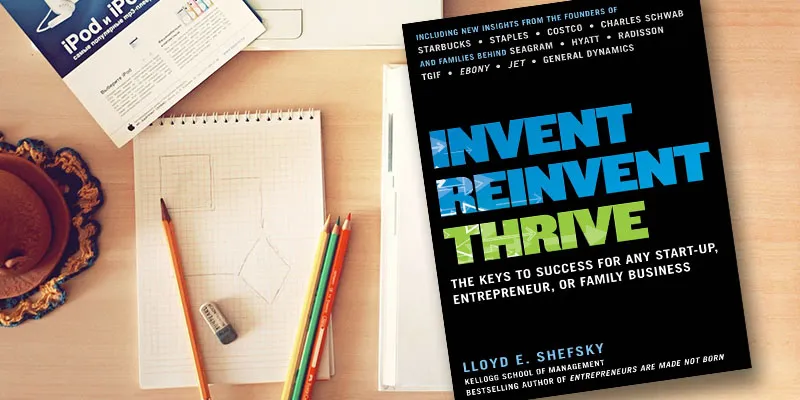Invent, scale, reinvent, thrive: 4 success steps for continuous innovation
The dawn of a New Year is a good day for introspection. Change is the only constant, and success at the professional and personal level requires long-term commitment, insights and passion. Lloyd Shefsky, Professor of Entrepreneurship at Kellogg School of Management, offers a range of tips and case studies in his new book, ‘Invent, reinvent, thrive: the keys to success for any startup, entrepreneur or family business.’ His earlier bestseller was ‘Entrepreneurs Are Made, Not Born.’

“Unlike in past generations, tomorrow’s great startups will entail multiple disciplines,” begins Shefsky in his 272-page book. Today’s generation wants immediate gratification and multiple job experiences, and the ‘on demand’ culture has replaced the ‘on request’ attitude.
Here are my key takeaways from the 14 chapters in the book. See also my pick of the Top 10 Books of 2014 for Entrepreneurs.
1. Reinvent yourself as an entrepreneur
Identify the problems that you see around you and work on improving them. What are the blind spots of incumbents? What insights can you cover from local and international markets? Can you map B2B learnings into the B2C market, or vice versa? What adjacent markets and niches are open? How passionately can you sell your vision to customers, employees and investors despite naysayers, negativism, dissenters and non-believers? How do you map and complement your weaknesses?
Such an approach led a number of entrepreneurs on their successful journeys: Tom Stemberg (Staples), Howard Schultz (Starbucks), James Freeman (Blue Bottle Coffee), Maxine Clark (Build a Bear), Larry Levy (The Levy Organisation) and Charles Schwab (Charles Schwab & Co.). They did not dismiss their critics but tried to understand their assumptions and motivations – these are useful sources of insights about customer needs, business positioning and the role of influencers.
“Silence the noise and leap the hurdles,” advises Shefsky, recommending the option of finding mentors. “When friends rebut, listen to your gut,” says Shefsky. However, skills from one discipline don’t always carry themselves to another – witness the many star athletes who have failed as businessmen. Taking the first entrepreneurial step is also a challenge, but that fear keeps people stuck in the corporate rut until it is “too late to fly like a butterfly.”
Don’t assume others know what you know; spend time to educate them about your product and develop a prototype product or experience – they may be seeing only individual jigsaw pieces and not the big picture. “Don’t blame potential investors if they are not getting it. Blame yourself for not explaining it well,” Shefsky advises.
“Every rejection is a lesson,” he adds, citing the example of financial entrepreneur Gil Mandelzis who had over 100 rejections before getting Sequoia as an investor in his startup Traiana.
2. Reinvent your business
“In business, reinventing isn’t everything, it’s the constant thing,” says Shefsky. Only reinvention gives you limitless possibilities, but it takes new mindsets and skillsets. Unfortunately, nine out of ten startups fail, in part due to inability to scale and lack of subsequent reinvention. To become a “reinventrepreneur” you have to change the filter on your lens.
But it is sometimes hard to tell what to change and what not change, as Jim Sinegal discovered when he changed the product mix in Costco. Testing, prototyping and nimble adaptation are needed here.
“Invite and reward good ideas. Don’t be afraid to admit you didn’t think of it,” Shefsky advises. For example, Gil Mandelzis of Traiana did not succumb to ‘not invented here’ (NIH) syndrome and was willing to accept colleagues' ideas over his own. “By involving others, the reinventions become more incremental and feasible,” says Shefksy.
Intel switched from a commodity product (memory chips) to an unproven invention (processors) – but must reinvent again to thrive in the era of Internet of Things (IoT). IBM lost out in PCs but came back with tech consulting services a generation later. Corning keeps reinventing new uses of glass.
“Kodak let its game-changing invention, a digital camera, collect dust on a shelf while its dominating film business died,” Shefsky explains as a cautionary tale. Ironically, it was Kodak engineer Steve Sasson who created the digital camera in 1975. But Kodak did not want to eat its own lunch and left itself wide open to competitors.
However, many companies are afraid of what he jokingly calls “premature evacuation.” Mergers and acquisitions are some possible options, but culture clash between the organisations can be a challenge.
“Reinvention does not come with a lifetime warranty,” cautions Shefsky. “Believe in luck but don’t rely on it,” he adds – you need skill to spot luck and grab it. Fifty years ago, Bruce Tuckman described the four stages of entrepreneurial development: forming, storming, norming and performing – Shefsky says this cycle must be repeated over and over again.
3. Reinvent yourself as a leader
“Maturity is no excuse. Reinvent or atrophy,” urges Shefsky. Creative destruction is the DNA of business, but overconfidence with past success or “destructive arrogance” gets in the way. Leaders, companies and even entire industries have had lapses which led to their demise.
Four motivators of reinvention are necessity, opportunity, desperation and addiction. Some entrepreneurs may choose to scale and reinvent their businesses over time – others choose the path of serial entrepreneurship.
John Osher rolled out a series of ventures one after another: electric toothbrushes (SpinBrush, sold to Proctor & Gamble), inexpensive electric razors and lighted leashes for pets. David Axelrod became an ace reporter for the ‘Chicago Tribune’ – then reinvented himself as a political strategist for PR campaigns. Nir Barkat founded software security firm BRM Technologies, and then became a mentor-investor for other startups such as CheckPoint.
Some entrepreneurs return to their original companies as “comeback leaders,” such as Steve Jobs and his second stint at Apple, and Howard Schultz who reinvented Starbucks when it went through a rough patch.
As entrepreneurs move to higher platforms, they need to master what Malcolm Gladwell calls “blink” – the art of thinking without thinking, or making nimble gut decisions.
4. Reinvent your management
Entrepreneurial leaders also need to create the next rung of leaders. “Operating requires different skills than founding,” explains Shefsky. For family businesses, succession planning has also been a tricky issue.
The author has done extensive research on family businesses (which account for over half the U.S. GDP) and addresses how to overcome vexing family disparities and enable family businesses to last more than two generations. Generational differences affect communications, and great leaders sometimes intimidate their progeny.
Seagram (Bronfman family), Hyatt Hotels (Pritzkers), Carlson and Radisson Hotels (Nelsons), and Johnson Publishing (Jet and Ebony magazines) are family owned businesses which have had their shares of ups and downs with “silver spoon” and “heir-archy” mentality, as well as definitions of loyalty and core competencies. “Businesses have value, families have values, and family businesses should have both,” advises Shefsky.
For all companies and leaders, changing times call for new skill sets. Success comes not just from asking questions like what, but also why and why not.
The book has a number of inspiring quotes, and it would be good to end this review with the following samples. (See also YourStory’s pocketbook ‘Proverbs and Quotes for Entrepreneurs: A World of Inspiration for Startups,’ accessible as apps for Apple and Android devices.)
“When you arrive at a fork in the road, take it.” – Yogi Berra
“Change is the law of life.” – John F. Kennedy
“I still have a photographic memory. I just no longer get same-day service.” – Charlie Munger, as told to Jim Sinegal
“Doing the same thing over and over again and expecting different results is insanity.” – Albert Einstein
“Managers do things right. Leaders do the right things.” – Warren Bennis
“Time goes, you say? Oh no! Alas, time stays, we go.” – Henry Austin Dobson
So go ahead – reframe, revitalise and rework in the new year and beyond!
About the author:
Lloyd Shefsky is Professor of Entrepreneurship at Kellogg School of Management, as well as founder and Co-Director of the school's Center for Family Enterprises and cofounder of its Center for Executive Women. Cofounder of several businesses and nonprofits, he has taught and lectured in a number of countries.







